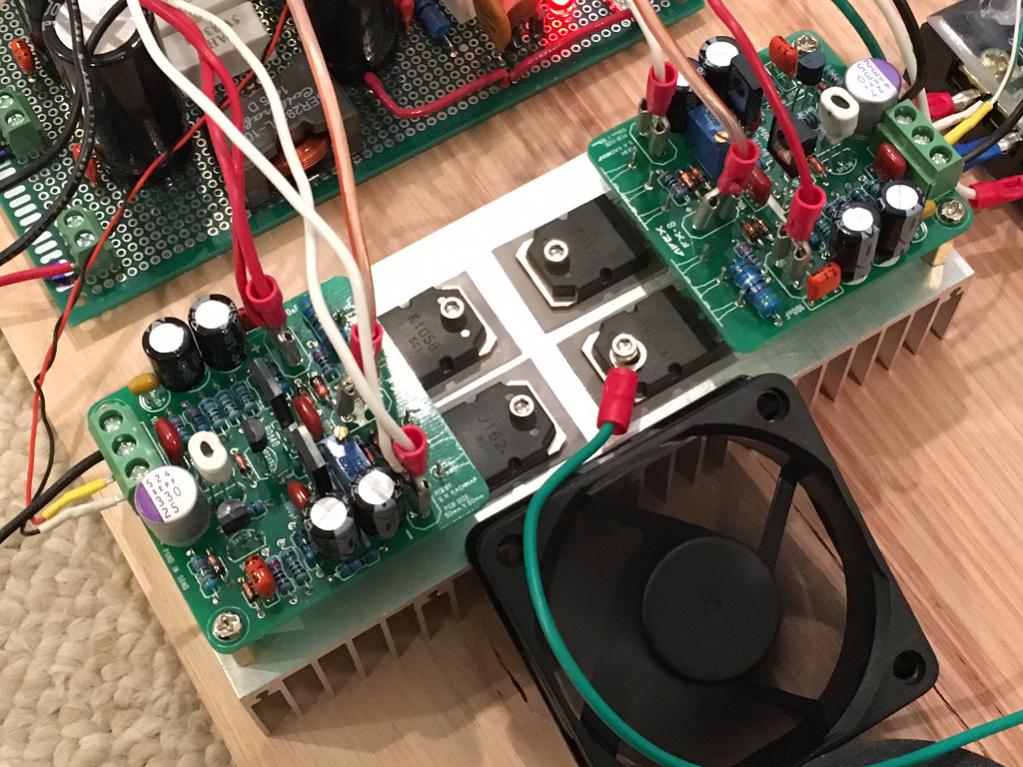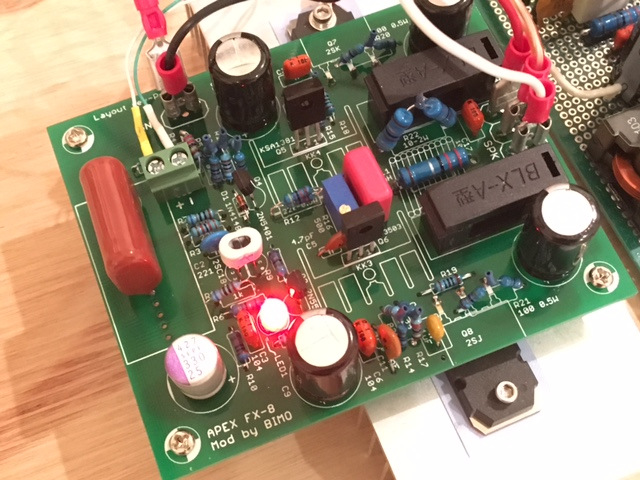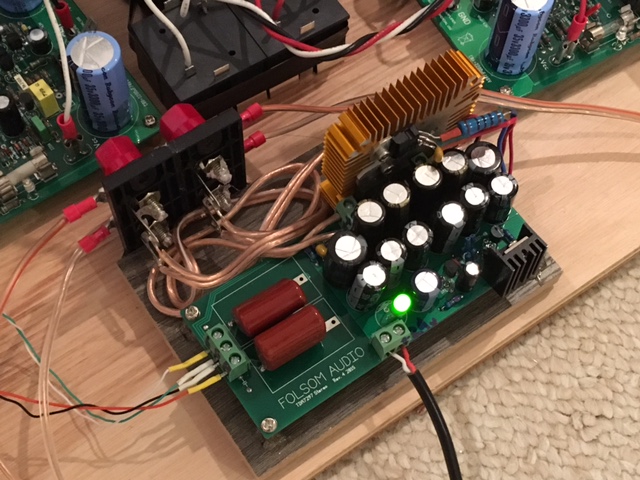Hi Octopusbeak. Do you have anything against using gainclones? They're super-simple to build, and you don't really need a PCB. I'm building one this evening, and I'm only building a chip amp because it will literally take less than an hour to complete. Also, no setup is required, and they have outstanding performance. I'm sure you can get them for $6 each, and the power supply need only be an 80VA 18-0-18 with two 2200uF filters, which shouldn't be more than $15. Say $30 for the amplifier, then you have $470 to spend on the speakers and turntable.
Out of interest, I built a pair of speakers now, and they are fantastic. I planned on using two gainclones, but I already have an amplifier built and working, but I did buy the LM3886's and components, and total cost was about $140 (including everything), and that's in South Africa where things are expensive. That would leave you with $360 to spend on a turntable, which is arguably the most important piece.
My build is mostly outlined here: Skytronic drivers. Now, I'm not saying it's the best you can do, but I personally am satisfied with the results. And the speakers are small, so easy to put wherever. Note that if you want to go very loud on inefficient speakers like these, you would need a 22-0-22 150VA transformer to power the amps.
Out of interest, I built a pair of speakers now, and they are fantastic. I planned on using two gainclones, but I already have an amplifier built and working, but I did buy the LM3886's and components, and total cost was about $140 (including everything), and that's in South Africa where things are expensive. That would leave you with $360 to spend on a turntable, which is arguably the most important piece.
My build is mostly outlined here: Skytronic drivers. Now, I'm not saying it's the best you can do, but I personally am satisfied with the results. And the speakers are small, so easy to put wherever. Note that if you want to go very loud on inefficient speakers like these, you would need a 22-0-22 150VA transformer to power the amps.
Certainly a chip amp will be easy to build but the sound quality between an LM3886 and a VHex+1 or other similar discrete class AB amp is like night and day. Even a very basic discrete solid state amp like an Apex FX8 (which btw, can be built in an hour) sounds much better. It's the bass authority and mid range clarity, and the high end transparency.
http://www.diyaudio.com/forums/solid-state/164093-100w-ultimate-fidelity-amplifier-747.html

A Chipamp will never beat a discrete amp in bass authority. You just have to look at how direct the electrical path is from supply rail to speaker output: it goes from 1 spade connector to get into the PCB then passes through 1 fat MOSFET transistor then back out to the output spade terminal to get the speaker.
http://www.diyaudio.com/forums/solid-state/164093-100w-ultimate-fidelity-amplifier-747.html

A Chipamp will never beat a discrete amp in bass authority. You just have to look at how direct the electrical path is from supply rail to speaker output: it goes from 1 spade connector to get into the PCB then passes through 1 fat MOSFET transistor then back out to the output spade terminal to get the speaker.
sound quality between an LM3886 and a VHex+1 or other similar discrete class AB amp is like night and day. Even a very basic discrete solid state amp like an Apex FX8 (which btw, can be built in an hour) sounds much better.
I cannot disagree with this more.
This is all dependent on how much power you prefer and what speakers you are driving. A chip amp can sound good at lower volume levels, but the suggested +/- 22V supplies will never be able to match the power output levels of a +/- 48V supplied amplifier. Depending on amp design and the chosen speakers, the extra supply voltage can have a huge effect on sound.
This is all dependent on how much power you prefer and what speakers you are driving. A chip amp can sound good at lower volume levels, but the suggested +/- 22V supplies will never be able to match the power output levels of a +/- 48V supplied amplifier. Depending on amp design and the chosen speakers, the extra supply voltage can have a huge effect on sound.
And that's the difference! 🙂
I cannot disagree with this more.
I design simple discrete amplifier with +-25VDC PSU. According to who built it, it better than ordinary non-inverting LM1875 amplifier.
Even relative simple discrete amplifier that design properly can have lower THD, higher slew rate, better S/N ratio than chip amp and it can have harmonic profile that you want.
I design simple discrete amplifier with +-25VDC PSU. According to who built it, it better than ordinary non-inverting LM1875 amplifier.
Even relative simple discrete amplifier that design properly can have lower THD, higher slew rate, better S/N ratio than chip amp and it can have harmonic profile that you want.
+1 - Bimo can really design a nice simple amp. My FX8 Bimo mod is fantastic.

The choice of transistors really made a difference in brining up the SQ another level.
I hear an AX11 Bimo edition is forthcoming...
I design simple discrete amplifier with +-25VDC PSU. According to who built it, it better than ordinary non-inverting LM1875 amplifier.
Even relative simple discrete amplifier that design properly can have lower THD, higher slew rate, better S/N ratio than chip amp and it can have harmonic profile that you want.
I've built better amplifiers than LM1875 based, but I had no experience with the LM1875 at the time. Better component selection could have made a big difference. And I'll add that there was nothing wrong with the LM1875. But LM1875 isn't LM3886, and LM3886 has much better performance.
The main problem is the power achievable with LM1875 - it's not easy to get good power, but with LM3886, it has excellent output voltage performance, and if you keep it tame, you can really get good results at its limits. But for everyday use, it's not easy to design a "better" amplifier, simply because they work so well.
I believe there is an emotional side to building a discrete amplifier that makes one think it sounds better, and I believe this because I was once there. I've listened to various amplifiers, including Rotel Class AB's, $100k Classe amplifiers, some NAD's, Onkyo's and Denons, I have built so many amplifiers that I can't count them, and I have built a chip amplifier. You want the expensive or "designed by you" amplifiers to sound better, but they just don't make much of a difference. Hifi is reproducing the audio signal (amplified) perfectly. If the chip does this, then what more can one do?
The only amplifiers I have heard a significant difference with are cheap class D amplifiers - they lack a fullness and sound thin. I believe this is because the output filters are not well designed (cheap).
And I am so willing to be proven wrong. The post office gave my parcel to someone else, so it looks like I'm not building my gainclone tonight, but when I do, I'll do an AB test and see if I hear a difference.
I believe there is an emotional side to building a discrete amplifier that makes one think it sounds better,
You can not design a good discrete amplifier by emotion or your feeling. You must understand how everything work and how to achieve your goal. You must know about components specification/datasheet, how to design good PCB layout, do some measurements, etc.
But, may be you can use emotion to choose what amplifier that you will build. 😉
You can not design a good discrete amplifier by emotion or your feeling. You must understand how everything work and how to achieve your goal. You must know about components specification/datasheet, how to design good PCB layout, do some measurements, etc.
But, may be you can use emotion to choose what you choose to build it. 😉
🙂 I agree, sorry, I mean an emotional side to the final product - you want (or think) it sounds better because you made it.
Hi Octopusbeak. Do you have anything against using gainclones? ...then you have $470 to spend on the speakers and turntable.
I don't have anything against it. Reading the discussion following your post, it looks like a gainclone will sound just fine at lower volumes, and like I said in my first post I don't need much volume at all. Even looking at the physical dimensions of the X-LS Encores I suspect they're more speaker than I'll need. I can afford them though, and if the amp I build isn't powerful enough to make use of them I can always scale up later.
The $500 figure did not include the turntable or phono stage. I'm all for cheap though. I can afford the VHex+, but it looks like a relatively big project compared to gainclones you all mentioned.
Feel free to share more links to the chipamps you're talking about, purchase pages, etc. I'll keep filtering through the forum links.
This may be obnoxious to say (handholding?), but a single post with all the links to boards and perhaps PSU components required (amp AND preamp if necessary) would be awfully convenient. I'm not afraid of reading, I swear, but I spend my days reverse engineering and it's the fastest way I'm going to learn.
Thanks all, I respect your passion.
If you are not opposed to chip amps, I have something that sounds excellent and is even simpler and less expensive. The TDA7297 class AB "lunch money amp". This chip in Destroyer OS' PCB sounds very nice. Capable of about 24w on a single rail 24 SMPS. A lot of work went into a TL431 shunt regulator to clean up the PSU ripple and lots of caps for low ESR supply. I have it fitted with a small fan cooled heatsink but you can just use a larger one without.
It drives my XL-S very admirably. Contact Destroyer OS for the "Folsom Audio" PCB. I can highly recommend it.
http://www.diyaudio.com/forums/chip-amps/231988-what-heck-its-less-than-lunch-97.html

It drives my XL-S very admirably. Contact Destroyer OS for the "Folsom Audio" PCB. I can highly recommend it.
http://www.diyaudio.com/forums/chip-amps/231988-what-heck-its-less-than-lunch-97.html

🙂 I agree, sorry, I mean an emotional side to the final product - you want (or think) it sounds better because you made it.
Luckily, many people built my amplifiers in my country 😉
And several people built my amplifiers and my modification here.
Hi. I unfortunately can't give a list of links, but I can direct you to one (two) more amplifier that I have built, and which I did find to sound particularly good. It shows relatively high harmonic distortion, but this adds to its tonality.
3 - 5 W class A amplifier
and its improved design (I have not built this)
7 W class A amplifier
I think there are a number of fantastic designs available here, and with your budget, you can really build something fantastic!
Let me know if you would like me to design a PCB for the amplifiers linked - I wouldn't mind starting a thread for that.
3 - 5 W class A amplifier
and its improved design (I have not built this)
7 W class A amplifier
I think there are a number of fantastic designs available here, and with your budget, you can really build something fantastic!
Let me know if you would like me to design a PCB for the amplifiers linked - I wouldn't mind starting a thread for that.
If someone is going to go to the effort of building an amplifier, why bother with a 5 watt design? There's pretty much no hope of ever being able to produce anything that resembles bass at that.
If someone is going to go to the effort of building an amplifier, why bother with a 5 watt design? There's pretty much no hope of ever being able to produce anything that resembles bass at that.
I agree to an extent, but a friend of mine built the 3-5 W circuit for a stereo amplifier powering two Celestion F15's and the bass was great. I mean, it's not for a subwoofer, but it was enough for listening to music, and not soft either.
Anyway, it's a 3 transistor circuit and it's a nice one. I agree it's possible to build a more powerful design, and possibly more suitable. As I said, there are plenty of fantastic things to build here, but if desired, I would be happy to design a PCB for the small class A design.
send a flat wideband signal through a flat wideband amplifier to a flat wideband speaker and the bass relative to the other frequencies is independent of the power delivered.If someone is going to go to the effort of building an amplifier, why bother with a 5 watt design? There's pretty much no hope of ever being able to produce anything that resembles bass at that.
many would use power amplifiers in the range 50W to 150W as their main amplifier. Yet their average listening power could be around 100mW to 1W.
They don't complain about no bass.
With the same average listening power from a 5W power amplifier will sound bass wise virtually identical to a 100W amplifier.
It's the way one rolls-off the bass, in the speaker and/or in the amplifier, that affects the relative bass to other frequencies, not the power.
Then you have a choice of 86dB to 88dB/W speakers for high power amplifiers, or 96dB to 98dB/W speakers for low power amplifiers.
Here you may find that the high efficiency speaker has lower bass output simply because of the size/efficiency/power compromise that affects all speakers. That is very different from an assertion:
no hope of ever being able to produce anything that resembles bass at that
send a flat wideband signal through a flat wideband amplifier to a flat wideband speaker and the bass relative to the other frequencies is independent of the power delivered.
many would use power amplifiers in the range 50W to 150W as their main amplifier. Yet their average listening power could be around 100mW to 1W.
They don't complain about no bass.
With the same average listening power from a 5W power amplifier will sound bass wise virtually identical to a 100W amplifier.
It's the way one rolls-off the bass, in the speaker and/or in the amplifier, that affects the relative bass to other frequencies, not the power.
Then you have a choice of 86dB to 88dB/W speakers for high power amplifiers, or 96dB to 98dB/W speakers for low power amplifiers.
Here you may find that the high efficiency speaker has lower bass output simply because of the size/efficiency/power compromise that affects all speakers. That is very different from an assertion:
Yes the average power used is low, but music is anything but average power, so that argument is pretty ridiculous. I've never heard a 5W amplifier that sounds the same as a "real" amplifier. They are always an irritating little noise box that makes it hard to hear the person beside you talk. They are especially irritating to some (like myself) with hearing damage.
100mW average to 5W (maximum power) allows for 17dB peaks.
But that personal requirement does not necessarily apply to all Members.
If you need much more than 100mW to 1W of avearge power, then you buy/build a more powerful amplifier.so that argument is pretty ridiculous.
But that personal requirement does not necessarily apply to all Members.
I have a 5w Pass class A amp (ACA) - within its limitations it can produce nice bass on the right speaker but of course in a smaller room. I use it at the office to power a single full range driver in a folded mass-loaded tapered quarter wave transmission line (mini Karlsonator). But I agree that if you want bass dynamics with enough headroom - a "real" amp with circa 50w minimum is needed to get some kick felt from a woofer.
I do like simple amp designs that can be made point to point on a small perfboard in an afternoon though. The 7w amp above is interesting from standpoint that a simple 24v SMPS could be used - and I have all of those components in my parts bin.
I do like simple amp designs that can be made point to point on a small perfboard in an afternoon though. The 7w amp above is interesting from standpoint that a simple 24v SMPS could be used - and I have all of those components in my parts bin.
Last edited:
- Status
- Not open for further replies.
- Home
- Amplifiers
- Solid State
- Beginner Solid State Amp (and speakers)